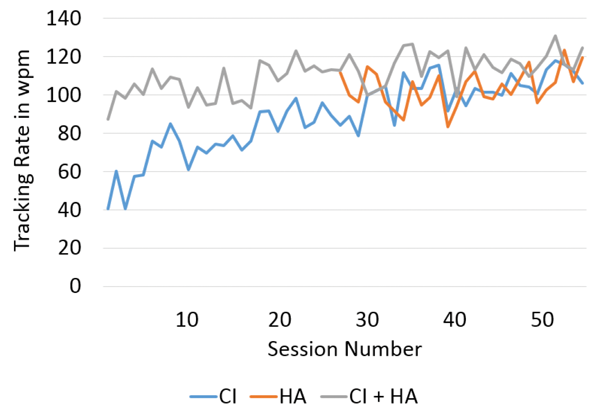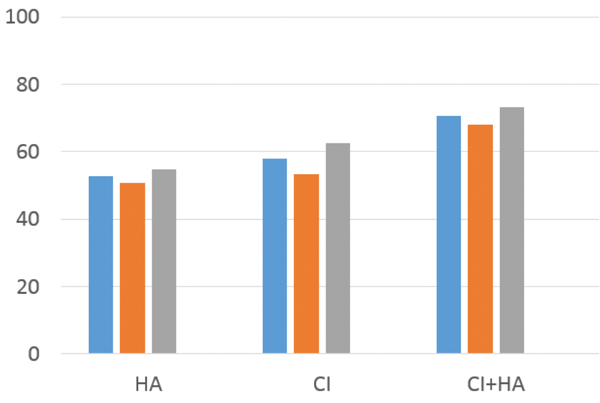When multi-channel cochlear implants (CIs) were first introduced in the 1980s, their use was restricted to people who derived no benefit from conventional amplification. Over the past three decades, however, the criteria for CIs has been relaxed considerably, and it has become increasingly apparent that CIs can provide great benefit not just for those with a profound hearing loss, but for many who are severely hard-of-hearing.
One area of emerging interest concerns adults with relatively good aided hearing in one ear, but little or no usable hearing in the other ear. Although many of these adults are able to cope in most everyday situations, and remain able, for example, to conduct telephone conversations, they still experience difficulties in adverse listening situations.
Case study subject
The subject of this case study is a woman in her late fifties who has had a hearing loss since early childhood. She was fitted with a hearing aid (HA) in her left ear at the age of seven years, and wore it during her school and college years. She was fitted with a HA in her right ear when she was in her twenties. The hearing in her left ear deteriorated around this time, and she stopped using a HA in that ear. Following an audiological evaluation in September 2013, which showed a severe-to-profound hearing loss in both ears, it was recommended that she should consider a CI in her left ear. Speech testing conducted during this evaluation showed CNC word recognition scores of 42% for her right ear and 0% for her left ear [1]. The subject works as a school nurse at a middle school and she hoped that a CI would make her able to communicate more easily and effectively with the students. One major motivation for getting a CI was her fear that her HL would increase and she would be unable to perform her job.
Pre-training testing
Live-voice auditory only testing was conducted by the author, using a list from the Composite Word Lists. Each list in this test consists of 25 pairs of monosyllabic words. The first word in each pair is formed using only voiced consonants and vowels / diphthongs with low second formant (F2) frequencies – low frequency (LF) words. The second word in each pair is formed using only voiceless consonants with vowels and diphthongs with high F2 frequencies – high frequency (HF) words. The subject scored 42% (LF words 60%, HF words 24%) overall for the test. Following the test, the subject was asked to rate the effort required to complete this task on a seven-point scale ranging from 1: ‘extreme effort’ to 7: ‘no effort at all’. She rated this test as requiring a great deal of effort (rating = 2). Two five-minute speech tracking sessions presented auditory only yielded tracking rates of 83.3 words-per-minute (wpm) and 92.2 wpm. Although the subject did not rate this task as being as difficult as the word test, she still felt that it required a lot of effort (rating = 4).
Training
The subject started training in late May 2014, only a few days after her CI had been activated, and she was still attending regular training sessions at the time that this paper was written in April 2015. The subject attended a total of 20 two-hour training sessions over this 10-month period. At first, training was provided in the CI alone and the CI+HA condition. Training in the HA only condition was introduced in the second half of the training period. The materials used included analytic and synthetic training activities, and all of the exercises were presented without lipreading cues. In the early stages of training, the subject reported that her understanding was good, but the sound was “tinny” and “metallic,” whereas sound in the HA alone or in the HA+CI condition was more “natural” and “warmer.”
Speech tracking
Speech tracking using the KTH Tracking Procedure [2] was an important part of the training approach adopted with this subject. The material used for speech tracking is ‘Kumanjayi’ a 162,000 word story that was written specifically for long-term training. The primary measure used is the subject’s tracking rate (TR) in wpm, which is derived by dividing the total number of words correctly identified in a single trial by the time elapsed. At first, the materials were presented auditory alone in the CI only and CI+HA conditions, and the HA only condition was introduced about halfway through the training period. This HA training was introduced in part because the subject reported that she no longer liked the sound of her HA, despite having worn one in that ear for more than 40 years. The purpose of this training was, at least in part, designed to highlight the value of her residual hearing in her right ear.

Figure 1: The subject’s tracking rates in words-per-minute for a text presented auditory alone via the cochlear implant (CI) only, the hearing aid (HA) only, and the combined cochlear implant plus hearing aid (CI+HA) conditions.
Figure 1 plots the subject’s mean TRs over more than 50 individual five-minute trials. The mean TR for the first five five-minute tracking sessions with the CI only was 51.4 wpm rising to 113.1 wpm for the last five five-minute sessions. The subject’s mean TRs for these trials in the CI+HA condition rose from 98.6 wpm to 121.0 wpm. It is interesting to note that the subject’s mean TR in the HA only condition was 111.7 wpm in the final five sessions which is almost identical to that obtained in the CI only condition. The subject now describes HA sound as “flat,” whereas that of the CI is “crisper” and “sounds have become crystal clear when I put it on.” She also feels that she is able “to concentrate more with the CI and do better.”
Word test
Three lists of the Composite Word Test were presented over a period of three training sessions, following four months of training. In each session, one list was presented in the CI only, HA only and CI+HA conditions. The order of presentation was varied from session to session so that each list was presented in each condition. No feedback was provided as to the correctness of the subject’s response. The subject’s scores for this material are presented in Figure 2. The mean overall scores for the three lists in the three presentation conditions were CI only 58%, HA only 52.7%, and CI+HA 70.7%. The results of this testing are shown in Figure 2.
Figure 2: The subject’s scores for three Composite Word Lists.
Each list was presented in the three sensory conditions – HA only, CI only and CI + HA.
Discussion
The subject’s performance in all three modalities is extremely impressive, and highlights the value of CIs for people who have little or no speech discrimination in one ear, but retain relatively good aided speech perception skills in the other ear. Although the subject’s TRs in all three presentation conditions are very high, there does appear to be an advantage when the CI and the HA are used together. It should be noted that the subject’s TRs in all three conditions are very high and compare quite favourably with other “exceptional” CI users with whom I have worked in the past.
The subject reports that she feels that listening is considerably easier when she uses the auditory and electrical signals together, and she feels that this is the optimal configuration at this time. She believes that her work situation has improved considerably since she received her CI. She is able to hear the pupils more easily, and around six months after activation reported that she heard an asthmatic “child wheeze for the first time ever.” She uses an electronic stethoscope coupled to her CI and HA for examinations, and this technology makes her more confident in her work.
The combined use of a CI and HA has been a great success for this subject. At this time she is not considering having her right ear implanted, but it remains an option if her hearing in that ear declines.
References
1. Causey GD, Hood LJ, Hermanson CL, Bowling LS. The Maryland CNC Test: Normative Studies. Audiology 1984;23:552-68.
2. Gnosspelius J, Spens K-E. A computer-based speech tracking procedure. Speech Transmission Laboratory Quarterly Progress and Status Report (QPSR) 1992;1:131-7.
SUMMARY
-
Case study of a woman who used a HA successfully in her right ear, but had no usable hearing in her left ear.
-
Received a CI in her left ear and attended training for twenty sessions. Steady growth in ability to use CI signal over the training period.
-
Subject reports that the combined CI+HA signal is preferred over either the CI or HA alone, and test results support this conclusion.
-
Results support the use of a CI for adults with one ‘dead’ ear, but good hearing with a HA in the other ear.
Declaration of Competing Interests: None declared.





